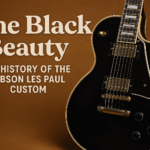Few companies have shaped modern music as profoundly as Fender. Renowned for its iconic guitar and bass designs, Fender has been at the forefront of innovation since its inception in the 1940s. From the Telecaster to the Stratocaster, Fender has crafted instruments that define genres, inspire musicians, and capture the essence of musical evolution.
Let’s explore the full history of Fender guitars, covering the company’s milestones, revolutionary models, and lasting influence.
1946: The Foundation of Fender
The story of Fender began in Fullerton, California, with Clarence Leonidas “Leo” Fender, a self-taught electronics enthusiast. Leo initially focused on repairing radios and amplifiers through his small business, Fender Radio Service, but his passion for sound innovation soon expanded into musical instruments. In 1946, he founded the Fender Electric Instrument Company, setting out to create groundbreaking amplifiers and electric instruments.
1950: The Birth of the Telecaster
Fender’s first major breakthrough came in 1950 with the introduction of the Broadcaster, later renamed the Telecaster due to a trademark dispute with Gretsch. The Telecaster was the first mass-produced, solid-body electric guitar. Its revolutionary design—featuring a bolt-on neck, two single-coil pickups, and a bright, cutting tone—made it an instant hit among musicians.
The Telecaster became synonymous with country and rock music, thanks to its simple yet versatile design. Musicians like Keith Richards, Bruce Springsteen, and Merle Haggard brought the Telecaster to life on stage.
1951: The Precision Bass
In the same year, Fender forever changed the role of bass in music with the introduction of the Precision Bass (P-Bass). Prior to its creation, bass players relied on bulky, difficult-to-transport upright basses. Fender’s P-Bass was portable, amplified, and easier to play, offering “precision” in tuning and tone.
The P-Bass became a staple in rhythm sections across genres, laying the foundation for modern rock, funk, jazz, and R&B. Iconic bassists like James Jamerson and Pino Palladino embraced the P-Bass, making it a cornerstone of modern music.
1954: The Stratocaster
If the Telecaster redefined electric guitar design, the Stratocaster revolutionized it. Released in 1954, the Stratocaster featured an ergonomic contoured body, a revolutionary tremolo bridge for pitch bending, and three single-coil pickups for tonal versatility. Its sleek and futuristic design captured the imagination of musicians and audiences alike.
Over the decades, legends like Jimi Hendrix, Eric Clapton, Buddy Holly, and Stevie Ray Vaughan made the Stratocaster a cultural icon. Its versatility and distinctive tone made it the go-to guitar for rock, blues, pop, and beyond.
1960: The Jazz Bass
In 1960, Fender introduced the Jazz Bass (J-Bass), catering to musicians seeking a bass with a slimmer neck, dual pickups, and more tonal variety. Initially designed for jazz players, the J-Bass quickly found its way into a wide range of genres, from rock to funk to fusion.
Bassists like Jaco Pastorius, Marcus Miller, and Geddy Lee used the Jazz Bass to craft their signature sounds, solidifying its reputation as one of the most versatile and expressive bass guitars ever created.
1965: CBS Acquires Fender
In 1965, Fender underwent a significant transition when it was sold to Columbia Broadcasting System (CBS) for $13 million. While CBS expanded Fender’s production capacity, it also introduced cost-cutting measures that led to a decline in quality. During the CBS era, many musicians began to favor pre-1965 Fender instruments, which are now highly sought after as “vintage” models.
Despite this dip in quality, Fender continued to innovate, introducing models like the Mustang, Jaguar, and Jazzmaster, which found a home in surf rock, punk, and indie music.
1985: Fender Rebirth Under New Ownership
By the early 1980s, Fender’s reputation had waned under CBS ownership. In 1985, a group of Fender employees, led by William Schultz, purchased the company and formed Fender Musical Instruments Corporation. This new leadership marked a return to quality and craftsmanship, with a renewed focus on honoring Fender’s legacy while meeting the needs of modern musicians.
The company launched the American Standard Series, a line of high-quality, U.S.-made instruments, and introduced custom shop offerings to appeal to professional players and collectors.
1990s and Beyond: Fender in the Modern Era
Fender’s resurgence in the 1990s cemented its place as a leader in the music industry. The introduction of affordable lines like Squier, designed for beginners and budget-conscious players, brought Fender instruments to a wider audience. Meanwhile, Fender’s Custom Shop continued to produce bespoke, high-end models for professionals and enthusiasts.
In addition to revitalizing classics like the Telecaster and Stratocaster, Fender expanded into new territories, producing signature models for artists like John Mayer, Eric Johnson, and Tom Morello. The company also embraced digital innovation with products like the Fender Play app and digital amplifiers.
Iconic Fender Models and Their Legacy
1. Telecaster (1950): Known for its simplicity, reliability, and sharp tone.
2. Precision Bass (1951): The world’s first electric bass guitar, transforming rhythm sections forever.
3. Stratocaster (1954): An ergonomic, versatile design beloved by legends across genres.
4. Jazzmaster (1958): Designed for jazz but embraced by surf rock and indie musicians.
5. Jazz Bass (1960): Slim, expressive, and a favorite among bassists of all styles.
6. Jaguar (1962): A surf rock classic that gained new popularity with punk and alternative players.
Fender’s Enduring Legacy
From crafting the tools of rock-and-roll to innovating in the digital age, Fender has maintained its position as a trailblazer in the music industry. Its instruments have become cultural icons, shaping the sound of generations and empowering musicians worldwide.
Today, Fender remains a symbol of innovation and artistry, proving that even after nearly eight decades, its commitment to quality and creativity continues to resonate with players of all skill levels.
Key Milestones in Fender’s Timeline
• 1946: Fender Electric Instrument Company is founded.
• 1950: Telecaster, the first mass-produced solid-body electric guitar, is released.
• 1951: Precision Bass redefines bass playing.
• 1954: Stratocaster revolutionizes electric guitar design.
• 1960: Jazz Bass debuts, offering a new standard for bass guitars.
• 1965: CBS acquires Fender, beginning a controversial era.
• 1985: Employees purchase Fender, restoring its quality and reputation.
• 1990s: Fender introduces affordable Squier guitars and relaunches classic models.
Fender’s history is a testament to Leo Fender’s vision and the company’s ability to adapt, innovate, and inspire. Whether you’re a budding guitarist picking up a Squier Strat or a seasoned pro wielding a Custom Shop Telecaster, Fender’s legacy is felt in every chord, riff, and melody played.







